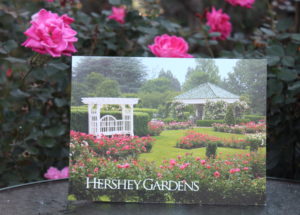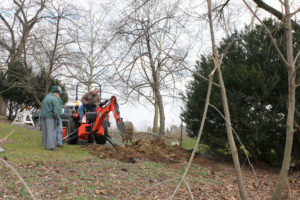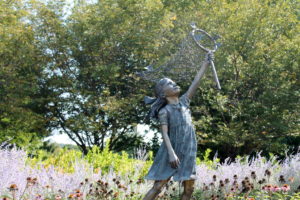New Book on Hershey Gardens
October 24th, 2017
Did you know that Hershey Gardens grew to more than just a rose garden because Milton Hershey was told the land there wasn’t good enough for either farming or housing?

The new Hershey Gardens book is available for $9.95 at Hershey Gardens and The Hershey Story museum.
How about that Hershey Gardens has some of the biggest, oldest tree species in Pennsylvania and the biggest nut-tree collection of any public garden in the United States?
Or that Hershey Gardens’ staff and volunteers yank the massive display of 20,000 tulips each spring, then replant new ones every fall?
All of that and more is laid out in a new, photo-filled, 50-page book about Hershey Gardens.
Written by Pamela Whitenack, director of the Hershey Community Archives, and yours truly, the book, “Hershey Gardens,” is now on sale for $9.95 in the Hershey Gardens gift shop and The Hershey Story museum. (Members get a 15 percent discount.)
Pam wrote the fascinating history about how this garden got started in 1936 and how it quickly grew into a world-famous rose garden.
It turns out that Mr. Hershey had been pondering a public garden for years when Harrisburg publisher and rosarian Horace McFarland broached the idea about Hershey funding a national rose garden in Washington.
Hershey replied, “Before we give that amount of money for the politicians to play with, we better spend some of it at our own place and see what interest people take in it.”
The day after he met with McFarland at a Pennsylvania Garden Club Federation meeting in Hershey, Mr. Hershey commissioned his head gardener, Harry Erdman, to get busy on what became a 12,000-bush rose garden by the following spring.
Hershey Rose Garden, as it was originally known, attracted more than 200,000 visitors that first year and eventually expanded to more than 42,000 roses by the 1940s. People could drive their cars through the park-like setting in those early years.
The Rose Garden quickly grew to 23 acres and took on scores of trees, beds full of seasonal plants, and the framework of the broader public garden that’s there today.
My role in the book was to try and convey the essence of Hershey Gardens, or as Longwood Gardens’ director Paul Redman calls it, Hershey’s “charm.”
Peel back the plants and you’ll find lots of under-stories that make this home-grown gem, well, charming.

A few years ago, Hershey Garden staff tried to unearth a slab at the secret spot where Milton Hershey used to sit. They never found it.
One little known factoid is that Mr. Hershey had a secret sitting spot at the garden’s edge, where he’d go in the evening in his later years to privately sit and read the paper.
Another one is just why Hershey decided to invest so much money in a free and open public garden. Erdman once mentioned after Hershey died that Hershey gave it as a “thank you to the people who bought his chocolate.”
That High Point Garden where you now see old-fashioned roses and boxwoods? That was originally called “Mrs. Hershey’s Rose Garden” because the plants were moved from the Hersheys’ High Point home after Catherine Hershey died young and Mr. Hershey donated the grounds to become the Hershey Country Club.
The fig tree that’s planted by the herb garden gazebo? That’s an offspring of the iconic fig that the Testa family had grown for decades for all to see at a busy town intersection. The original is now gone.
And that statue of the “Girl Chasing Butterflies” in the Bill Bowman Garden? That was a statue that Bowman loved and that his friends bought as a centerpiece for the garden after Bowman died.
The whole place is filled with memories and special spaces and plants, not to mention how the Gardens serve as a living garden catalog for just about every bulb, perennial, annual, shrub and tree worth growing in central Pennsylvania.
It’s far more than a nice collection of roses. The bulb display is stunning in spring, the beds of annuals are impressive all summer, and the woody-plant foliage blazes in fall.
Now that the Gardens last year added the Milton and Catherine Hershey Conservatory with its Butterfly Atrium, it’s open all year and worth visiting even in winter.
The new book is filled with superb photos that capture all of those features and more.
I’m dumbfounded by how many locals have never visited Hershey Gardens and how many more say they were there once (maybe decades ago) but haven’t seen it lately.
If you’re in that category, it’s time for a look. Check out the Children’s Garden, the nut grove, the butterflies, the statues, the thousands of flowers, and, of course, the roses.
Milton Hershey would be heartened to know that people are taking a keen interest in his botanical thank-you 80 years later.








